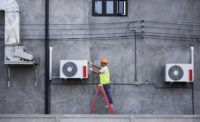ASHRAE Standard 62.1, “Ventilation for Acceptable Indoor Air Quality,” is the gold standard for maintaining indoor air quality in occupied spaces. The standard allows for engineers to demonstrate compliance through multiple pathways, such as natural ventilation and mechanical ventilation. This article focuses on integrating the requirements of 62.1 for mechanical ventilation with variable refrigerant flow (VRF) systems.
VRF Systems — The Basics
VRF systems are direct expansion heat pump systems in which multiple indoor units are connected to a common condensing unit, which can be either air or water source via a refrigerant piping network.
VRF systems utilize inverter-driven compressors, which vary their speed and refrigerant displacement based on total system operating conditions. This helps improve efficiencies compared to conventional systems and reduces energy consumption during part-load conditions. The speed of the compressor is determined by the high- and low-side saturation temperature and pressure as well as how far they are the predetermined target values determined by the unit’s control board logic. In the cooling mode, the target evaporation saturation temperature is approximately 43°F, and, in heating mode, the target condensing temperature is approximately 115°. These temperatures are important to keep in mind because they will ultimately determine the discharge air temperature from the fan coil, which may impact ventilation rates required by ASHRAE 62.1.
Capacity is controlled at the indoor units as well. The expansion valves at the indoor coil are electronic expansion valves that can modulate in steps between fully open and fully closed to reach the desired opening percentage. These expansion valves modulate the amount of refrigerant through the indoor unit’s coil based on the room set point, actual return or room air (measured through either a return air sensor or at the remote controller if available) temperature, superheat at the coil (if in cooling mode), or subcooling at the coil (if in heating mode). This control is important to consider in ventilation design as these units will likely not be able to control to a discharge air temperature set point.
VRF Fan Coil Design
Production line indoor units, as shown in Figure 1, typically range from 0.5-8 nominal tons of cooling capacity. Ducted indoor units typically produce the rated cfm at static pressures between 0.4-0.8 inches of WC. These parameters are important to keep in mind, as the sensible heat ratio will ultimately determine the unit’s ability to dehumidify outside air, and the static pressure capabilities need to be reviewed to ensure the pressure drop outside air filtration (typically MERV 11 or 13) plus the installed ductwork will not impede the unit’s airflow.
At the time of writing, production model VRF fan coils are typically limited to three row coils, which are arranged in blow-through configurations. Indoor units typically have a sensible heat ratio between 0.7-0.85 at nominal conditions and airflows ranging between 325-450 cfm/ton.
These variations are very important for a designer to consider, as changes to the sensible heat ratio will impact the discharge air temperature to the space. In Figure 2, we can see how the discharge air temperature is affected by the sensible heat ratio of three different fan coil capacities from the same model. Delivering a supply air with a dew point higher than that of the occupied space will gradually increase the humidity ratio in the space and can make occupants feel uncomfortable and “clammy.” This is often overlooked but can result in occupants lowering cooling set points in order to feel more comfortable.
It’s also worth noting that engineers must consider the entering air temperature at the VRF unit’s coil. Typical allowed operating ranges for standard VRF fan coils is 58° WB to 82° WB in cooling operation and 58° DB to 80° DB in heating operation.
If outside air is delivered to the fan coil to distribute to the occupied space, designers must ensure the mixed-air temperature entering the face of the coil does not exceed these limits for prolonged periods to avoid equipment shutdowns or faults. The mixed-air temperature will also impact the coil’s performance in cooling and heating mode. The cooling coil rating at AHRI conditions is based on 80° DB/67° WB and 70° DB for heating. If the air entering the coil deviates from these temperatures, the coil’s performance will deviate from the catalog ratings. For cooling, lowering the entering air temperature reduces the coil capacity and in heating will raise the coil capacity. This is a function of the log mean temperature difference between the refrigerant and air temperatures across the coil, which becomes important when selecting a ventilation strategy.
For “ductless” VRF terminal units, manufacturers commonly advertise the ability to integrate certain percentages of outside air; this is typically common for cassette-type units. Based on past experiences, I strongly recommend determining the mixed-air temperature and making sure it is within the operating limits of the equipment rather than relying on outside air percentages.
Dedicated Outside Air Systems
For applications that require higher latent capacities and higher airflow or static pressure capabilities, it’s possible to connect some third-party fan coils and air handlers to VRF condensers using control valve kits supplied by several VRF manufacturers. Most VRF manufacturers can also provide a catalog-model ducted fan coil for use with higher and lower entering air temperatures. Typically, these units will allow outside air temperature between 23° DB and 95° DB/85° WB. Capacities will vary across OEMs, and these units typically have additional application considerations to adhere to.
Designers should also consider that outside air loads may not vary too much throughout the day, particularly during peak conditions, and that caution should be taken when applying diversity factors to VRF systems, where the condensers are connected to both DOAS and comfort conditioning terminal systems.
Another option is to use a completely separate system to condition the outside air. This can be accomplished with packaged units and air handlers capable of larger cfm and temperature ranges, capacity control, and more stringent filtration. Many package DOAS units are also being rated via AHRI Standard 920, “Performance Rating of DX Outside Air System Units,” allowing designers to properly evaluate their efficiencies.
Methods of Outside Air Delivery
The ASHRAE Design Guide for Dedicated Outside Air Systems identifies three delivery methods for mechanical ventilation — direct, integrated, and decoupled.
Each of these methods has its own set of pros and cons.
The Direct Method
The direct method is based on delivering treated outside air to the occupied space. The ventilation air can be delivered directly to the space through a dedicated duct or can be connected to a fan coil or air handler used for comfort cooling. In either case, the cooling and heating coil(s) of the space’s air handler or fan coil must be sized appropriately and pick up the space and building load for outside air. The direct method is typically the cheapest design option, as there is no DOAS unit or energy recover ventilator (ERV) used for pretreating the outside air; however, additional capacity required by the comfort cooling unit(s) may increase equipment costs.
The downside to the direct method is that untreated outside air will be delivered to the space with no heating or cooling until the space thermostat calls for it because the heating and cooling coils are activated by space temperature. This is of interest during mild ambient temperatures with high humidity.
With the direct method, it’s important to consider that the filtration requirements for outside air still need to be included.
The Integrated Method
In the integrated method, a dedicated outside air unit or energy recovery unit is used to pretreat the outside air for delivery to the occupied space. The pretreating is designed to condition the outside air to remove both sensible and latent loads from the cooling and heating coils. How much pretreating is dependent on the design team, who should evaluate the situation based on cost and feasibility.
In the integrated method, the preconditioned outside air can be delivered by ducting it to the return of the air handler or fan coil or delivering it directly to the space, where it will mix with the room air. Some of the benefits offered by this arrangement include improved indoor air quality and thermal comfort, improved energy efficiency, a simple arrangement to install, balance, and control, a balance between performance and first cost, and the elimination of the need for DOAS terminal reheat.
One negative about the integrated method is that failure of the pretreatment unit can result in loss of temperature control in the space if the terminal equipment cannot handle the extra ventilation load.
Another scenario to be mindful of is if the pretreated outside air mixing with the return air lowers the mixed air temperature at the terminal unit’s cooling coil below AHRI conditions, the coil capacity may need to be de-rated, resulting in a larger unit or coil being required.

The Decoupled Method
The decoupled method uses a dedicated outside air system to fully condition the ventilation air so that no additional treatment is required by the fan coil or air handler used for comfort cooling. This approach can reduce the capacity requirements of the terminal equipment as it no longer has to pick up any of the ventilation load. In cooling operation, the DOAS unit will typically condition the outside air to a dew point temperature below that of the space humidity ratio, which results in a supply air temperature low enough to also offset some of the space’s sensible cooling load. By ducting this treated outside air directly to the occupied space, the fans at the terminal unit can be shut off, saving fan energy. Another benefit is that any capacity de-rates resulting from lower mixed air temperatures at the cooling coil are eliminated.
Conclusion
We reviewed several key characteristics of VRF systems and how they will impact the integration of outside air required by building codes. Designers should consult their local mechanical codes for specific ventilation requirements as well as other codes for specific building types, such as health care or education. Additional methods of compliance are discussed in ASHRAE 62.1, and ASHRAE also supplies a user’s manual that offers guidance on applying the standard to projects. Readers that seek to learn more about designing mechanical ventilation systems should consult the ASHRAE DOAS Design Guide and the ASHRAE Handbook of Fundamentals for further information.




